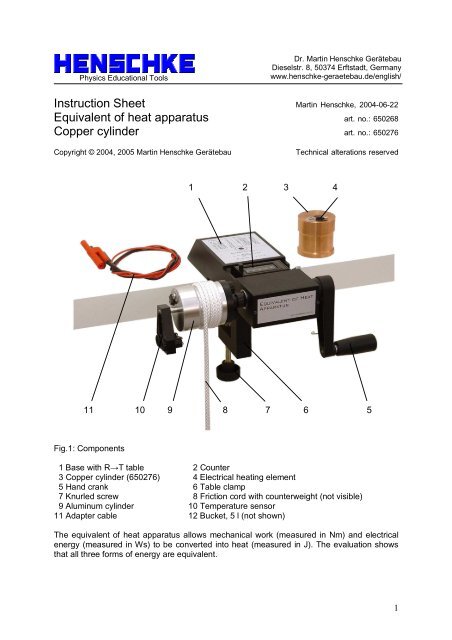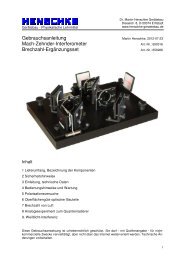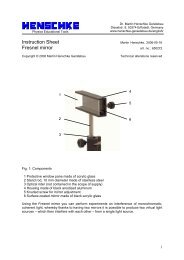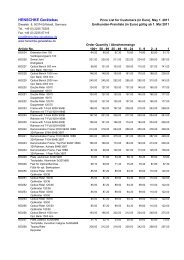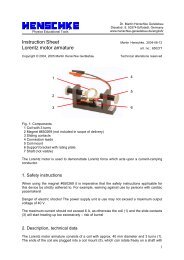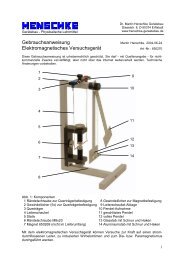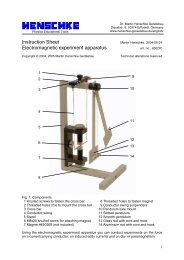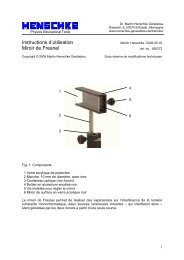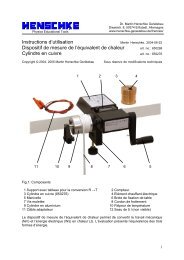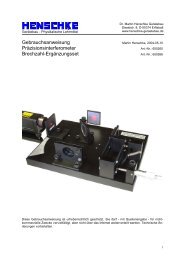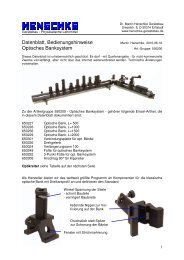Equivalent-of-Heat-Apparatus.pdf - Martin Henschke Gerätebau
Equivalent-of-Heat-Apparatus.pdf - Martin Henschke Gerätebau
Equivalent-of-Heat-Apparatus.pdf - Martin Henschke Gerätebau
Create successful ePaper yourself
Turn your PDF publications into a flip-book with our unique Google optimized e-Paper software.
Physics Educational Tools<br />
Dr. <strong>Martin</strong> <strong>Henschke</strong> Gerätebau<br />
Dieselstr. 8, 50374 Erftstadt, Germany<br />
www.henschke-geraetebau.de/english/<br />
Instruction Sheet <strong>Martin</strong> <strong>Henschke</strong>, 2004-06-22<br />
<strong>Equivalent</strong> <strong>of</strong> heat apparatus art. no.: 650268<br />
Copper cylinder art. no.: 650276<br />
Copyright © 2004, 2005 <strong>Martin</strong> <strong>Henschke</strong> Gerätebau<br />
Technical alterations reserved<br />
1 2 3 4<br />
11<br />
10<br />
9 8 7<br />
6<br />
5<br />
Fig.1: Components<br />
1 Base with R T table 2 Counter<br />
3 Copper cylinder (650276) 4 Electrical heating element<br />
5 Hand crank 6 Table clamp<br />
7 Knurled screw 8 Friction cord with counterweight (not visible)<br />
9 Aluminum cylinder 10 Temperature sensor<br />
11 Adapter cable 12 Bucket, 5 l (not shown)<br />
The equivalent <strong>of</strong> heat apparatus allows mechanical work (measured in Nm) and electrical<br />
energy (measured in Ws) to be converted into heat (measured in J). The evaluation shows<br />
that all three forms <strong>of</strong> energy are equivalent.<br />
1
1. Safety instructions<br />
Risk <strong>of</strong> injury! The (approx. 5 kg) weight attached to the cord 8 can cause injury to persons<br />
if it falls on them. It should be placed on the ground to secure it and not be raised more than<br />
about 10 cm during the experiment.<br />
Risk <strong>of</strong> burning! During the experiments the friction cylinder (3 or 9) is heated. It should be<br />
observed that the temperature does not rise above about 40 °C. The maximum permissible<br />
current through the heating element is 2 A and may not be exceeded.<br />
Risk <strong>of</strong> electric shock! The maximum output voltage <strong>of</strong> the power supply used for the<br />
electric heating may not be greater than 40 V.<br />
2. Description, technical data<br />
The equivalent <strong>of</strong> heat apparatus can be used to show the equivalence <strong>of</strong> mechanical work<br />
due to friction (Nm), electrical energy (Ws) and heat (J). The values measured in Nm or Ws<br />
agree to an accuracy <strong>of</strong> about 2%. If this equivalence is assumed, the specific heat capacity<br />
<strong>of</strong> aluminum and copper can be determined.<br />
The stable design with its integrated rotary counter and a dual ball-bearing mounted shaft<br />
make experiments as simple as possible to perform. To measure temperature a negative<br />
temperature coefficient thermistor (NTC) is used. This is safely contained inside an aluminum<br />
sleeve. The aluminum sleeve snaps into the friction cylinder so that it cannot slide out<br />
unintentionally.<br />
Technical data for the friction cylinders (approximate values):<br />
Diameter D = 48 mm<br />
Height H = 50 mm<br />
Aluminium cylinder: mass m A = 250 g,<br />
specific heat c A = 0,86 kJ/kg K,<br />
Copper cylinder: m K = 750 g,<br />
c K = 0,41 kJ/kg K<br />
Electrical connection: sockets <strong>of</strong> 2 mm diameter, positive pole “+” isolated, negative pole “–”<br />
connected to ground, reversal <strong>of</strong> polarity does not destroy the equipment.<br />
3. Operation and maintenance<br />
The equivalent <strong>of</strong> heat apparatus is attached to a stable workbench using its table clamp.<br />
The friction cord is then wrapped around the friction cylinder 4½ to 5½ times with the<br />
counterweight suspended at the rear and the loose end <strong>of</strong> the cord hanging down at the<br />
front.<br />
The bucket provided can be filled with water or sand etc. (total weight approx. 5 kg) and used<br />
as a weight. The loose end <strong>of</strong> the friction cord is attached to the weight while the latter is<br />
resting on the ground. It should be observed that the counterweight should be no more than<br />
about 5 cm above the ground when the cord is taut. This prevents the weight being raised by<br />
more than about 10 cm during the experiment.<br />
If it is observed that the cord moves to the right when the crank is turned or fails to remain in<br />
its groove, then the cord should be wrapped around the cylinder so that the end <strong>of</strong> the cord<br />
with the weight is on the right and that with the counterweight is on the left.<br />
The temperature sensor should be wetted with a drop <strong>of</strong> oil (important!) and inserted into the<br />
selected friction cylinder according to Fig. 1 until it is felt to snap into place and can be turned<br />
2
easily (if it is inserted too far or not far enough, it is not easy to turn it). The two connections<br />
<strong>of</strong> the temperature sensor are attached to a resistance meter (multimeter) operating in the<br />
range 2 k to 9 k with a display accurate to at least three figures. The conversion <strong>of</strong> the<br />
resistance so measured into a corresponding temperature can be performed either with the<br />
help <strong>of</strong> the conversion table on the last page <strong>of</strong> these instructions or by using the following<br />
equation:<br />
217<br />
T = − 151<br />
(1)<br />
R<br />
0.13<br />
where R must be given in k to obtain T in °C. This equation agrees with the table provided<br />
by the NTC thermistor manufacturer in the range from 10 - 40 °C to an accuracy <strong>of</strong><br />
approximately ± 0.05 °C.<br />
Before an experiment the friction cylinder should be cooled to about 5 - 10 °C below the<br />
ambient temperature. This can be achieved by putting it in a refrigerator or by dipping it in<br />
cold water. In the latter case the hole for the temperature sensor should point upwards and<br />
the cylinder may only be immersed to a depth <strong>of</strong> about 2/3 the height <strong>of</strong> the cylinder (tip: if<br />
the friction cylinder is dipped in water inside a plastic bag, it will not need to be dried <strong>of</strong>f again<br />
when it has finished cooling).<br />
The rise in temperature during an experiment should continue until the friction cylinder’s<br />
temperature has been raised to about 5 - 10 °C above the ambient temperature. The more<br />
precisely the temperature differences for cooling and heating (with respect to the ambient<br />
temperature) are similar, then the smaller is the net exchange <strong>of</strong> heat with the environment.<br />
For heating the friction cylinder electrically, adapter cables are provided with plugs <strong>of</strong> 2 mm<br />
diameter at one end and conventional 4 mm lab plugs at the other. The power should be<br />
provided by a power supply where voltage and current limiting can be regulated. The<br />
maximum voltage from the power supply may not exceed 40 V. The positive pole <strong>of</strong> the<br />
power supply is connected to the isolated socket (identifiable due to the round, gray plate<br />
beneath the socket) and the negative is connected to the other socket.<br />
The heating elements for the friction cylinders behave nearly like ohmic resistors with round<br />
about 11 . The maximum rating is 36 W. So a maximum <strong>of</strong> 20 V and the resulting current <strong>of</strong><br />
about 1.8 A should not be exeeded. To calibrate an operating point it is recommended that<br />
the current limiting is set at 1.00 A and the voltage limiting is set at 15 V. These settings are<br />
not altered thereafter until the current is broken simply by pulling out the cables at the time <strong>of</strong><br />
the experiment.<br />
Maintenance: the equivalent <strong>of</strong> heat apparatus in principle requires no maintenance. It can<br />
be wiped clean with soap and water. Solvents should not be used. Immersion in water should<br />
also be avoided.<br />
The friction cylinders should be plain naked metal. If a coating has formed on them, this can<br />
be removed using metal cleaner.<br />
The friction cord can be washed if necessary. For a good value alternative, woven nylon cord<br />
can be used as a replacement.<br />
3
4. Experiment procedure and evaluation<br />
4.1 Conversion <strong>of</strong> mechanical work into heat<br />
4.1.1 Experiment procedure<br />
First the various masses are measured:<br />
Primary weight (e.g. bucket with water) m H = 5,22 kg<br />
Counterweight (attached to friction cord) m G = 0,019 kg<br />
Aluminum cylinder m A = 0,249 kg<br />
Other values to be measured in advance:<br />
Ambient temperature T U = 23,2 °C<br />
Diameter <strong>of</strong> cylinder where friction occurs D R = 45,75 mm<br />
After cooling the cylinder, it should be screwed to the base, the temperature sensor should<br />
be inserted and the friction cord should be wrapped around it. (cf. Section 3). After a few<br />
minutes, that should be ignored for the sake <strong>of</strong> a homogenous temperature distribution, the<br />
resistance <strong>of</strong> the temperature sensor is R 1 = 8.00 k (corresponding to T 1 = 14.60 °C by<br />
Eq. 1).<br />
After zeroing the counter, the experiment is begun by turning the crank and thus lifting the<br />
primary weight from the ground. This slightly loosens the cord so that it causes less friction<br />
on the cylinder. The primary weight no remains at the same height and should remain there<br />
for the rest <strong>of</strong> the experiment.<br />
After n = 460 turns the experiment is halted and the resistance value read <strong>of</strong>f: R 2 = 3.99 k<br />
(T 2 = 30.26 °C). Since the temperature continues to rise for a short time after the experiment<br />
is completed (homogenizing the temperature distribution), the minimum value <strong>of</strong> the<br />
resistance is noted as the measured value. This is reached a few seconds after the end <strong>of</strong><br />
the experiment. After that the resistance increases again since heat is exchanged with the<br />
environment to cool the cylinder down to a lower temperature.<br />
4.1.2 Experiment evaluation<br />
Work W is defined as the product <strong>of</strong> force F and displacement s<br />
W = F s . (2)<br />
The force <strong>of</strong> friction acting is<br />
F = m g<br />
(3)<br />
A<br />
(g is the acceleration due to gravity) in the direction <strong>of</strong> the displacement<br />
s = nπ<br />
. (4)<br />
D R<br />
Placing Equations 3 and 4 into Equation 2 gives:<br />
W = mAg nπ DR<br />
= 5 ,22x9,81<br />
x460x3,1416<br />
x0,04575 Nm=<br />
3386 Nm . (5)<br />
The heat stored in the friction cylinder Q is determined from the temperature difference<br />
(T 2 – T 1 ) and the specific heat capacity given in Section 2:<br />
∆Q<br />
= cA mA( T2 −T1 ) = 0,86 x0,249<br />
x(30,26<br />
−14,60)kJ<br />
= 3353J<br />
(6)<br />
In this example the disagreement between the mechanical work and the heat energy is found<br />
to be no more than about 1%. Due to unavoidable tolerances relating to the composition <strong>of</strong><br />
materials (aluminum is very s<strong>of</strong>t and almost impossible to work mechanically, so that it is<br />
always alloyed), the specific heat capacity can fluctuate quite noticeably. The specific heat<br />
4
capacity is most easily calculated by heating it electrically using the equivalence between<br />
heat and electrical energy.<br />
4.2 Conversion <strong>of</strong> electrical energy into heat<br />
4.2.1 Experiment procedure<br />
After cooling the friction cylinder it should be screwed into the base (the same experimental<br />
conditions as for the friction experiment) and the temperature sensor inserted. After a few<br />
minutes that should be ignored for the sake <strong>of</strong> homogenous distribution <strong>of</strong> temperature, the<br />
resistance <strong>of</strong> the temperature sensor is R 1 = 8.00 k (corresponding to T 1 = 14,60 °C by<br />
Eq. 1).<br />
Now the power supply that has been configured in advance (see Section 3) should be<br />
connected to the heating element and a stopwatch started. Voltage and current (as displayed<br />
by the power supply) should be noted: U = 11.4 V, I = 1.00 A<br />
After t = 300 s the experiment is halted and the resistance <strong>of</strong> the sensor is read <strong>of</strong>f: R 2 = 3.98<br />
k (T 2 = 30.32 °C). Also the end voltage is noted: U = 11.0 V.<br />
4.2.2 Experiment evaluation<br />
The electrical energy E is the product <strong>of</strong> power P and time t. The power is the product <strong>of</strong><br />
voltage (for calculation the mean voltage is used) and current. Therefore:<br />
E = U I t = 11 ,2x1,00<br />
x300<br />
= 3360 Ws<br />
(7)<br />
In this experiment, the heat added is<br />
∆Q<br />
= cA mA( T2 −T1 ) = 0,86 x0,249<br />
x(30,32<br />
−14,60)kJ<br />
= 3366 J<br />
(8)<br />
The agreement between E and Q is very good in this experiment as well.<br />
5
Relationship between resistance and temperature <strong>of</strong> the temperature sensor<br />
R / k T / °C R / k T / °C R / k T / °C R / k T / °C R / k T / °C<br />
7,86 14,97 6,78 18,19 5,70 22,05 4,62 26,84 3,54 33,10<br />
7,84 15,03 6,76 18,26 5,68 22,13 4,60 26,94 3,52 33,24<br />
7,82 15,08 6,74 18,32 5,66 22,21 4,58 27,04 3,50 33,38<br />
7,80 15,14 6,72 18,39 5,64 22,29 4,56 27,14 3,48 33,51<br />
7,78 15,19 6,70 18,45 5,62 22,37 4,54 27,24 3,46 33,65<br />
7,76 15,25 6,68 18,52 5,60 22,45 4,52 27,35 3,44 33,79<br />
7,74 15,31 6,66 18,58 5,58 22,53 4,50 27,45 3,42 33,93<br />
7,72 15,36 6,64 18,65 5,56 22,61 4,48 27,55 3,40 34,07<br />
7,70 15,42 6,62 18,72 5,54 22,69 4,46 27,66 3,38 34,22<br />
7,68 15,47 6,60 18,78 5,52 22,77 4,44 27,76 3,36 34,36<br />
7,66 15,53 6,58 18,85 5,50 22,85 4,42 27,87 3,34 34,50<br />
7,64 15,59 6,56 18,92 5,48 22,94 4,40 27,97 3,32 34,65<br />
7,62 15,64 6,54 18,99 5,46 23,02 4,38 28,08 3,30 34,79<br />
7,60 15,70 6,52 19,05 5,44 23,10 4,36 28,18 3,28 34,94<br />
7,58 15,76 6,50 19,12 5,42 23,19 4,34 28,29 3,26 35,09<br />
7,56 15,81 6,48 19,19 5,40 23,27 4,32 28,40 3,24 35,24<br />
7,54 15,87 6,46 19,26 5,38 23,35 4,30 28,51 3,22 35,39<br />
7,52 15,93 6,44 19,33 5,36 23,44 4,28 28,62 3,20 35,54<br />
7,50 15,99 6,42 19,40 5,34 23,52 4,26 28,72 3,18 35,69<br />
7,48 16,05 6,40 19,46 5,32 23,61 4,24 28,83 3,16 35,84<br />
7,46 16,10 6,38 19,53 5,30 23,69 4,22 28,95 3,14 36,00<br />
7,44 16,16 6,36 19,60 5,28 23,78 4,20 29,06 3,12 36,15<br />
7,42 16,22 6,34 19,67 5,26 23,87 4,18 29,17 3,10 36,31<br />
7,40 16,28 6,32 19,74 5,24 23,95 4,16 29,28 3,08 36,47<br />
7,38 16,34 6,30 19,81 5,22 24,04 4,14 29,39 3,06 36,63<br />
7,36 16,40 6,28 19,88 5,20 24,13 4,12 29,51 3,04 36,79<br />
7,34 16,46 6,26 19,95 5,18 24,21 4,10 29,62 3,02 36,95<br />
7,32 16,52 6,24 20,03 5,16 24,30 4,08 29,74 3,00 37,11<br />
7,30 16,57 6,22 20,10 5,14 24,39 4,06 29,85 2,98 37,28<br />
7,28 16,63 6,20 20,17 5,12 24,48 4,04 29,97 2,96 37,44<br />
7,26 16,69 6,18 20,24 5,10 24,57 4,02 30,09 2,94 37,61<br />
7,24 16,75 6,16 20,31 5,08 24,66 4,00 30,20 2,92 37,78<br />
7,22 16,81 6,14 20,39 5,06 24,75 3,98 30,32 2,90 37,94<br />
7,20 16,88 6,12 20,46 5,04 24,84 3,96 30,44 2,88 38,11<br />
7,18 16,94 6,10 20,53 5,02 24,93 3,94 30,56 2,86 38,29<br />
7,16 17,00 6,08 20,60 5,00 25,02 3,92 30,68 2,84 38,46<br />
7,14 17,06 6,06 20,68 4,98 25,11 3,90 30,80 2,82 38,63<br />
7,12 17,12 6,04 20,75 4,96 25,21 3,88 30,92 2,80 38,81<br />
7,10 17,18 6,02 20,83 4,94 25,30 3,86 31,04 2,78 38,99<br />
7,08 17,24 6,00 20,90 4,92 25,39 3,84 31,17 2,76 39,17<br />
7,06 17,30 5,98 20,97 4,90 25,48 3,82 31,29 2,74 39,35<br />
7,04 17,37 5,96 21,05 4,88 25,58 3,80 31,42 2,72 39,53<br />
7,02 17,43 5,94 21,12 4,86 25,67 3,78 31,54 2,70 39,71<br />
7,00 17,49 5,92 21,20 4,84 25,77 3,76 31,67 2,68 39,90<br />
6,98 17,55 5,90 21,28 4,82 25,86 3,74 31,79 2,66 40,08<br />
6,96 17,62 5,88 21,35 4,80 25,96 3,72 31,92 2,64 40,27<br />
6,94 17,68 5,86 21,43 4,78 26,05 3,70 32,05 2,62 40,46<br />
6,92 17,74 5,84 21,50 4,76 26,15 3,68 32,18 2,60 40,65<br />
6,90 17,81 5,82 21,58 4,74 26,25 3,66 32,31 2,58 40,84<br />
6,88 17,87 5,80 21,66 4,72 26,34 3,64 32,44 2,56 41,04<br />
6,86 17,93 5,78 21,74 4,70 26,44 3,62 32,57 2,54 41,23<br />
6,84 18,00 5,76 21,81 4,68 26,54 3,60 32,70 2,52 41,43<br />
6,82 18,06 5,74 21,89 4,66 26,64 3,58 32,84 2,50 41,63<br />
6,80 18,13 5,72 21,97 4,64 26,74 3,56 32,97 2,48 41,83<br />
6


